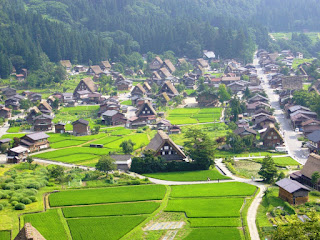(For once I got my way) So, once all the arrangements were made - dates, time-off work, accommodation e.t.c. - we (yours-truly + better-half, mother-in-law, sister-in-law and family dog) set off. As my sister-in-law is a good driver, I was happy to hand-over the reins to her allowing me to take in the beautiful scenery during our 4-hour drive.
 |
| Map Location |
 |
| Map Location. |
 |
| Chilling-Out In The Onsen. |
First stop of the day was the Hida Great Limestone Cave. As you wound your way through the illuminated complex, you emerged at the top before descending and returning to a picturesque garden, and onto the souvenir shops for the traditional Omiyage. Videos - Hida Great Limestone Cave - Gardens & Entrance.
 |
| Map Location. |
 |
| Takayama Tourist Attractions. |
 |
| Ginkgo Bilboa Tree, at Hida Kokubunji Temple. |
Video - Hida Kokubunji Temple.
Takayama Jinya was our next destination. We were very privileged when one of the staff gave us a personal tour of the building. If it wasn't for this kind person, we would have wandered-around not knowing much of what we were looking at.
 |
| Entrance to Takayama Jinya. |
 |
| Sanmachi. |
 |
| Sake Shop. |
As the girls were keen to sit-and-relax in a cafe, I headed-off to meet my "Facebook Friend", Akila Tanaka. Akila-san is employed by the Takayama Municipal Office as their "Overseas Promotions Officer". I have shared many of Akila's posts - Visit Hida Takayama (Official), Japan.
 |
| Shirakawa-go Map Location. |
In the image above, taken during rice-growing season (August - September), the town looks very picturesque. But, in Winter, Shirakawa looks just as inviting (albeit very cold). The best time of day to visit Shirakawa, I would suggest early morning. That way you will avoid the hoards of tourist buses. Don't be in a rush to experience this quaint delight. And, if possible, take the path up to the Shiroyama Viewpoint (where the images were taken) for an overall look of the area. If you are travelling here from Takayama, take Route-158 &156 (like we did) and you will be treated to some of that great Japanese scenery along the way. Video - Shirakawago + The Village from top floor of house + Rice Fields + Walking in the Rain
Sadly it was time to hit-the-motorway and return home. I am so grateful to Akila, Hisa and friends for telling me about Hida-Takayama. It was an experience that will take some beating, which is why it has been placed on our "Must Return" list. For me, I am looking at returning with my mountain-bike so I can check-out other scenic spots in the area. Maybe spend a week here. I hope you can place Hida-Takayama on your list of places to visit when you come to Japan. You won't be disappointed.
Takayama City Videos.



























